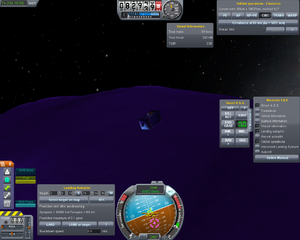Difference between revisions of "Eve"
(It's != Its) |
(Added planetbox) |
||
| Line 1: | Line 1: | ||
| − | + | {{Planetbox | |
| − | + | |Class=Planet | |
| − | + | |File=Eve_map.png | |
| − | + | |imgdesc=Eve as seen from orbit in version 0.17 | |
| + | |Parent=[[Kerbol]] | ||
| + | |Axism=9833000 | ||
| + | |Axisau=~0.0657295452 | ||
| + | |orbitv=11,028 | ||
| + | |longitude=15 | ||
| + | |argperi=15 | ||
| + | |anomaly=?? | ||
| + | |peroidh=1574.47 | ||
| + | |periodd=65.6029 | ||
| + | |soikm=85,109 | ||
| + | |soirad=~121.6 | ||
| + | |radius=700 | ||
| + | |mass=1.224E+23 | ||
| + | |density=85221 | ||
| + | |gravityv=16.671305 | ||
| + | |gravityg=1.7 | ||
| + | |gparam=?? | ||
| + | |esc=?? | ||
| + | |rotation=22.5 | ||
| + | |day=?? | ||
| + | |geosync=10372 | ||
| + | |geostation=?? | ||
| + | }} | ||
'''Eve''' is the second [[planet]] from [[Kerbol]], and only available in versions 0.17 and higher. It is purple in appearance. It has one small asteroid moon called [[Gilly]]. | '''Eve''' is the second [[planet]] from [[Kerbol]], and only available in versions 0.17 and higher. It is purple in appearance. It has one small asteroid moon called [[Gilly]]. | ||
| Line 8: | Line 31: | ||
Eve is the closest planet to Kerbin and the easiest to reach, requiring the least Delta-V of any planet. Having a similar size to Kerbin gives it a large gravity well and a thick atmospheric composition makes landings easier. | Eve is the closest planet to Kerbin and the easiest to reach, requiring the least Delta-V of any planet. Having a similar size to Kerbin gives it a large gravity well and a thick atmospheric composition makes landings easier. | ||
| + | == Topography == | ||
| − | + | [[File:Eve.png|thumb|left|Orbiting Eve]] | |
| − | + | [[File:Eve_isa_mapsat.png|thumb|left|A topographic map of Eve made with the ISA MapSat plugin]] | |
| − | |||
| − | |||
| − | |||
| − | |||
| − | |||
| − | |||
| − | |||
| − | |||
| − | |||
| − | |||
| − | |||
| − | |||
| − | |||
| − | |||
| − | |||
| − | |||
| − | |||
| − | |||
| − | |||
| − | |||
| − | |||
| − | |||
| − | |||
| − | |||
| − | |||
| − | |||
| − | |||
| − | |||
| − | |||
| − | |||
| − | |||
| − | |||
| − | |||
| − | |||
| − | |||
| − | |||
| − | |||
| − | |||
| − | |||
| − | |||
| − | |||
| − | |||
Eve has large oceans of liquid mercury and large, flat continents with a few mountain peaks, and a large crater in the western hemisphere. The surface looks like purple sand dunes. | Eve has large oceans of liquid mercury and large, flat continents with a few mountain peaks, and a large crater in the western hemisphere. The surface looks like purple sand dunes. | ||
Revision as of 19:14, 24 September 2012
Eve is the second planet from Kerbol, and only available in versions 0.17 and higher. It is purple in appearance. It has one small asteroid moon called Gilly.
Eve is the closest planet to Kerbin and the easiest to reach, requiring the least Delta-V of any planet. Having a similar size to Kerbin gives it a large gravity well and a thick atmospheric composition makes landings easier.
Topography
Eve has large oceans of liquid mercury and large, flat continents with a few mountain peaks, and a large crater in the western hemisphere. The surface looks like purple sand dunes.
Atmosphere
The atmosphere begins ~100 KM. When you are inside the atmosphere, Eve appears indigo-blue during nighttime. During dawn and dusk, the sky is green. The atmosphere is very thick, and slows you down to (roughly) 130 m/s at 11 KM, 110 m/s at 8.5 KM, 100 m/s at 7.5 KM, 90 m/s at 6 KM, 80 m/s at 4.3 KM. At this point it stops decelerating you. The atmosphere is probably composed of iodine given its purple coloration.
Natural Satellites
Eve's only natural satellite is the tiny asteroid Gilly which has been captured long ago.

